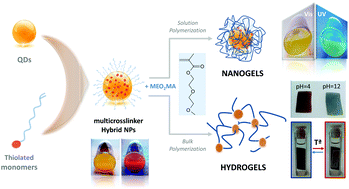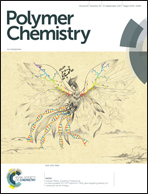QDs decorated with thiol-monomer ligands as new multicrosslinkers for the synthesis of smart luminescent nanogels and hydrogels†
Abstract
Herein, new smart thermo-responsive photoluminescent nano- and macrogel hybrids based on quantum dots (QDs) and poly(diethylene glycol methyl ether methacrylate) (pMEO2MA) are reported. The synthetic strategy comprises the functionalization of the homemade hydrophobic CdSe nanoparticles (NPs) with thiol-functionalized methacrylic monomers via ligand exchange reactions. Therefore, the organic–inorganic hybrid QD NPs decorated with methacrylic groups are able to connect the inorganic core with the growing pMEO2MA chains during the radical polymerization reaction by acting as multicrosslinker nanoagents. Depending on whether the bottom-up polymerization approach is conducted in solution or in bulk, nanometric core–shell QD@pMEO2MA NPs or hybrid pMEO2MA hydrogels crosslinked by QD NPs are achieved, respectively. Both nanogel and hydrogel hybrids experience a considerable and sudden increase in the fluorescence emission upon heating due to gel collapse at the volume phase transition temperature (VPTT), independent of pH. Moreover, at very basic pH (pH 12), the hydrogels also undergo a colour change from red to fully blue, which makes them promising as pH sensors. Both pH- and thermo-response are reversible in both nano- and macro-gel materials.



 Please wait while we load your content...
Please wait while we load your content...